The Build Back Better Act recently promoted in Congress incorporates many elements of the Biden Administration’s “American Families Plan,” which is promoted as “an investment in our kids, our families, and our economic future.”REF The plan indeed represents a substantial “investment:” As the largest expansion in means-tested welfare in United States history, it raises total government support by $11,300 to $76,400 per poor family with children.REF However, due to the poor incentive structure of these welfare benefits, the Biden family plan is more accurately described as an “investment” in non-marriage and broken families.
The Welfare System and Marriage
The federal government operates nearly 90 means-tested welfare programs that provide cash, food, housing, medical care, childcare, and social services to poor and lower-income persons. Major programs include Temporary Assistance for Needy Families; the Earned Income Tax Credit (EITC); Supplemental Security Income (SSI); Section 8 Housing; public housing; food stamps; the Women’s, Infants, and Children food program (WIC); and other child nutrition programs; and Head Start and other childcare programs. In 2018, federal and state governments spent $527 billion on means-tested aid programs for poor and lower-income families with children.REF
The welfare system discourages and disincentivizes marriage through two mechanisms.
- The first is the enabling or facilitating effect of welfare in sustaining single-parent families. This effect occurs when government welfare programs increase the economic viability of single parenthood and reduce the relative economic necessity and utility of fathers and marriage as a means of support.
- The second mechanism is direct marriage penalties imposed on marriage by the welfare system. Marriage penalties occur because nearly all welfare programs are structured so that most lower-income parents will lose significant welfare benefits if they marry. The combined economic resources of parents will generally be higher if they are unmarried rather than married. This obviously discourages marriage in low-income communities.
Welfare’s Enabling Effect on Single-Parent Families
The enabling or facilitating effect is the first mechanism by which the welfare system discourages and undermines marriage. This effect occurs when welfare encourages and sustains the formation of single-parent families that would be unlikely to emerge in the absence of welfare support. It has played a powerful role sustaining both the long-term growth of single parenthood and the decline of marriage.
When the War on Poverty began in 1964, 7 percent of children were born outside of marriage. Today, the share is 40 percent.REF Nearly all of this growth in non-marital childbearing has occurred among less-educated women. Some 59 percent of children of mothers with only a high school diploma are born outside of marriage. Among college-educated women, the number is only 10 percent.REF
Increasingly, our society is dividing into a two-caste system.REF In the higher-income half of society, children are raised by parents with college educations who are united in marriage. In the lower-income half, children are increasingly raised by single parents with a high school diploma or less.
The nation faces a paradoxical situation in which marriage has eroded primarily among less-educated women who will have the greatest difficulty supporting children on their own. Many of these women would find it very difficult to support their children financially without the continued support of the large array of welfare programs.REF
Historically, nearly all of the support for the enormous number of children now born outside of marriage would have been provided by fathers. However, in the decades after the onset of the War on Poverty, the number and value of cash, food, housing, and medical benefits available to single-parent families increased substantially.REF The non-marital childbearing rate, after remaining largely flat for decades, began to surge between 1964 and 1975, precisely the period in which the value of the average benefit package provided to single mothers nearly doubled.REF
Increased welfare benefits began to serve as partial substitutes for the economic support traditionally provided by lower-wage fathers. As welfare began to displace working fathers from the home, marriage declined, and non-marital childbearing soared.REF
The Build Back Better Act Undermines Family Formation
The Build Back Better Act increases government support for poor families with children by an average of $11,300 per family. Nearly all of the benefit initiatives contained in the bill and supported by the Biden Administration generally, including food stamp increases, public housing increases, child allowance cash grants, and childcare subsidies, disproportionately benefit non-married single-parent families relative to married families. The large increase in benefits—disproportionately aiding non-married families with children—would exacerbate the existing system’s enabling effect of promoting increases in single-parent families and the harmful erosion of marriage in our society.
Direct Marriage Penalties in the Welfare System
The second mechanism by which the welfare system discourages marriage is through direct marriage penalties in means-tested welfare programs. Marriage penalties exist whenever the act of marriage between a father and mother leads to a direct reduction in welfare benefits.
Marriage penalties occur because the benefits in means-tested welfare programs are generally reduced when earnings or other income within the family are increased. In a married-couple family, benefits are almost always linked to the combined earnings of the husband and wife: The higher the joint earnings, the lower the benefits. If a single mother marries an employed father, the father’s income will be counted in the benefit calculation, and benefits in most cases will be sharply reduced. The benefit loss can be avoided if the couple decides not to marry.
Means-tested benefits thus have an inherent family-splitting effect. In most cases, father and mother will receive greater benefits if they remain unmarried and present themselves to the government as separate units rather than forming a single married couple. Among most lower-income families, marriage penalties mean that the combined economic resources of the parents will be lower if they marry than they will be if they remain unmarried.
How Build Back Better Increases Marriage Penalties
The Biden plan, as embodied in the Build Back Better Act, increases marriage penalties in five important ways:REF
- Increased Child Tax Credit cash grants for parents with little or no work. Under current law, the earnings-based phasing in of cash grants provided under the Child Tax Credit not only encourages work, but also partially offsets marriage penalties elsewhere in the welfare system in the case of couples for whom one member’s earnings are insufficient to claim the full credit of $2,000 per child. Under the Biden plan, the maximum benefit of $3,000 or $3,600 per child is provided to those with no work, and there is no longer an incentive to work, much less marry, to receive the full benefit.
- Increased Earned Income Tax Credit for childless workers. Under current law, a small benefit for childless workers phases in and then out at such a low income that few full-time workers receive any credit. Under the Biden plan, the maximum benefit nearly triples to $1,502 and does not fully phase out until income reaches $21,427. This approach to assisting such individuals has proven ineffective at reducing poverty or increasing employment,REF and these benefits will ordinarily be forfeited if a couple marries.
- Increased food stamp benefits. The Biden Administration’s 21 percent administrative increase in food stamp benefits raises the amount that will be lost if a single mother marries a father with moderate income.
- Increased availability of public housing. By increasing funding and the number of subsidized families by 40 percent to 50 percent, the Biden plan subjects more families to the single most severe marriage penalty in the welfare state, ordinarily equal to 30 percent of the husband’s earnings—on top of the penalties they face in other programs. Some 90 percent of families with children who are receiving public or Section 8 housing aid are single-parent families.REF Married-couple families with children rarely receive housing subsidies, partly because their long-term incomes are too high for the family to receive priority on U.S. Department of Housing and Urban Development (HUD) waiting lists.
- A new income-based childcare entitlement. By capping childcare costs as a share of family income, the new universal childcare entitlement discourages a working mother from marrying the working father of her children, as they will be expected to pay a portion of his income for childcare only if they marry. This program creates substantial new marriage penalties for upper-middle-class couples that rival the worst penalties currently faced by those in the bottom half of the income distribution.
Marriage Penalty Examples for Law-Abiding Couples
The following examples illustrate the increased marriage penalties (or divorce bonuses) for representative families under the Biden plan as embodied in the Build Back Better Act:
- Example 1: An unmarried mother of two earning $15,000 gains public housing under the Biden plan. The father earns $20,000. They stand to lose $11,121 if they marry. The mother’s income is roughly half the median for unmarried mothers, and the father’s income is roughly half the median for unmarried men. Under current law, the couple gains $990 in tax relief and $925 in cash grants from the Child Tax Credit by filing taxes jointly, partially offsetting the marriage penalties in the EITC and the Supplemental Nutrition Assistance Program (SNAP), so their net marriage penalty is $3,372, or 7 percent of their net income. Under the Biden plan, their Child Tax Credit is unaffected by marriage, and they bear the full marriage penalty of $5,121 from the federal tax code and food stamps. In addition, when the mother gains access to public housing, they face an additional marriage penalty of $6,000, raising their total marriage penalty to $11,121, or 15 percent of their net income. (See Appendix Table 1.)
- Example 2: An unmarried mother of two earning $30,000 gains access to subsidized childcare under the Biden plan. The father earns $40,000. They stand to lose $5,881 if they marry. The mother’s income is near the median for unmarried mothers, and the father’s income is near the median for unmarried men. Under current law, this mother’s earnings are nearly sufficient to qualify for the full Child Tax Credit without factoring in the father’s income, and the couple faces a small income tax marriage penalty due to the existence of head-of-household tax-filing status.REF The EITC accounts for $3,773 of their $4,468 marriage penalty, which equals 7 percent of their net income. Under the Biden plan, they gain access to subsidized childcare, and their combined income remains just low enough so that they are not expected to contribute to its cost in most states. In most states, the mother qualifies for newly expanded food stamp benefits if the father is excluded from the household, and their marriage penalty increases to $5,881, or 7 percent of their net income. (See Appendix Table 2.)
- Example 3: A married couple earning $50,000 each, with two children, gains access to subsidized childcare under the Biden plan. They are penalized $3,279 for being married. This couple’s combined income of $100,000 is near the median for married couples with children. Under current law, they face a small marriage penalty of $835, or about 1 percent of their net income, because of head-of-household tax-filing status. Under the Biden plan, the mother becomes eligible for fully subsidized childcare if not married, and the couple is expected to contribute $2,444 toward the cost of childcare if they marry, resulting in a total marriage penalty of $3,279, or 3 percent of their net income. (See Appendix Table 3.)
- Example 4: A married couple earning $75,000 each and with two children gains access to subsidized childcare under the Biden plan. They could save $12,173 if they divorce. This couple’s combined income of $150,000 is about 50 percent above the median for married couples with children. Under current law, they face a marriage penalty of $2,828, or 2 percent of net income, entirely because of head-of-household tax-filing status. Under the Biden plan, they become eligible for a childcare subsidy of $13,845 if unmarried but only $4,500 if married, so by divorcing, they could gain $12,173, or 9 percent of their net income. (See Appendix Table 4.)
Marriage Penalties for Families Receiving Fraudulent Welfare Payments
Welfare benefits are contingent on the reported composition of the family receiving benefits. The apparent location and income of absent, non-custodial, or cohabiting non-married fathers is of particular importance. There is no mechanism in place to ensure that couples provide accurate information concerning family membership—or even that they consistently provide the same misinformation—to welfare agencies and to the IRS regarding their living arrangements. Therefore, it is generally possible for unmarried couples to increase benefits by concealing a father’s income from welfare agencies even if he resides in the household. Similarly, non-married couples may optimize which parent claims each child for EITC purposes even if they do not live in the same household and therefore are not legally allowed to receive benefits.
In these ways, unmarried couples can maximize their total government benefits with flexibility and impunity. Cheating by providing inaccurate information to the IRS or welfare agencies is very common.REF The following examples illustrate the increased marriage penalties for additional representative families under the Biden plan as embodied in the Build Back Better Act, assuming that each non-married family reports living arrangements to maximize benefits.
-
Example 5: A nonworking unmarried mother of two gains access to public housing under the Biden plan. The father earns $25,000. They stand to lose between $8,940 and $14,928 if they marry. The father’s income is more than half the median for unmarried men. Under current law, the couple gains $1,154 under the EITC and loses $3,598 in SNAP benefits if they marry, so their net marriage penalty is $2,444, or 7 percent of their net income. Under the Biden plan, they gain $620 in Child Tax Credit cash grants and $1,154 under the EITC but lose $3,214 in SNAP benefits if they marry. Furthermore, when the mother gains access to public housing, they face an additional marriage penalty of $7,500, raising their total marriage penalty to $9,940, or 16 percent of their net income. (See Appendix Table 5.)
In addition, because subsidized housing programs prioritize lower-income families on their waiting lists, it is difficult for married couples to enter these programs and receive benefits. If the mother marries the father while she is contemplating or waiting to receive these benefits, the father’s income could push the couple so far down the priority list that they effectively lose access to the benefit altogether. In this case, the total marriage penalty would include the full value of the housing benefit for the nonworking unmarried mother and would total $14,928, or 27 percent of their net income.REF
-
Example 6: An unmarried couple earning $22,500 each and with two children gains access to subsidized housing and childcare under the Biden plan. They stand to lose $14,913 if they marry. Both have income somewhat below the median for unmarried parents. Under current law, they lose $395 in Child Tax Credit cash grants, $4,417 under the EITC, and $1,657 in SNAP benefits if they marry, so their total marriage penalty is $6,469, or 12 percent of their net income. Under the Biden plan, they lose $625 in Child Tax Credit cash grants, $4,417 under the EITC, and $3,133 in SNAP benefits if they marry. Furthermore, when the mother gains access to public housing, they face an additional marriage penalty of $6,738. Their income is low enough that they are eligible for fully subsidized childcare regardless of their marital status. However, the Biden plan raises their total marriage penalty to $14,913, or 19 percent of their net income. (See Appendix Table 6.)
The Overall Pattern of Welfare Marriage Penalties
Chart 1 shows the general pattern of welfare marriage penalties under the Build Back Better Act for dual-earner families with children at various income levels. The vertical (Y) axis shows the aggregate benefit loss if unmarried parents choose to marry.REF The colored areas show the amount of benefits lost under each program. The horizontal (X) axis shows the family’s combined earnings.REF
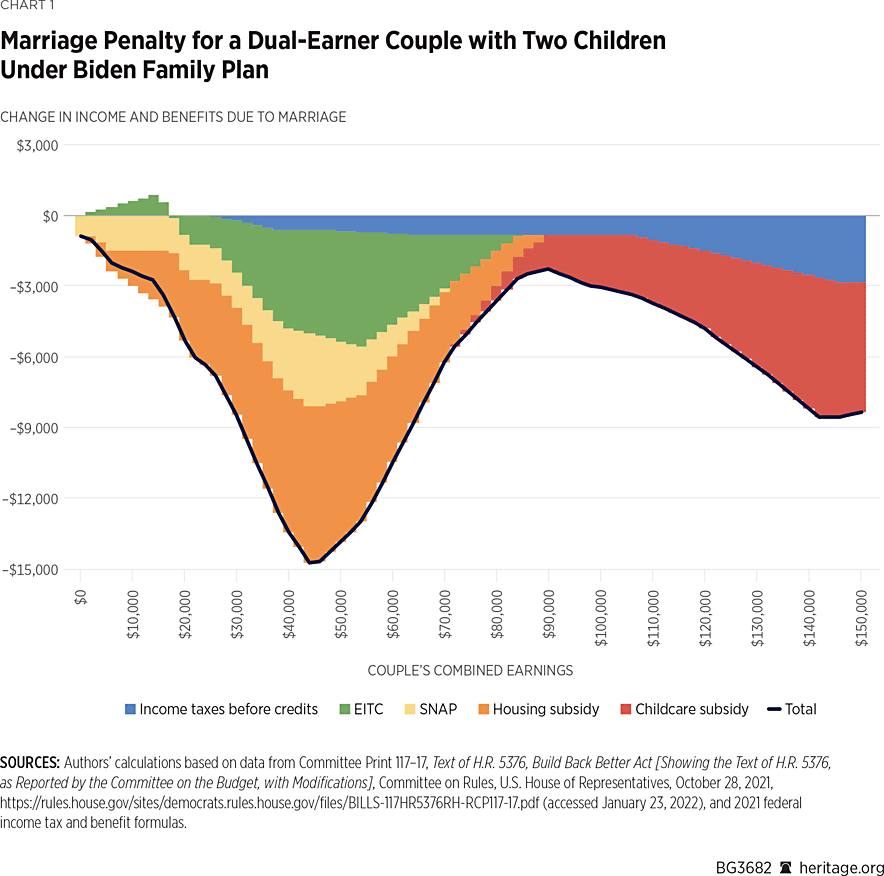
The chart shows that marriage penalties under the Build Back Better Act are bimodal with benefit losses peaking at two different income levels. Under the Biden plan, dual-earner couples with joint earnings in the $30,000 to $70,000 range who have two children would face a marriage penalty ranging from $3,000 to $7,000 from taxes, credits, and food stamps. This makes marriage financially unattractive for many lower-income and middle-income couples. The provision of housing benefits to an increased number of unmarried mothers exacerbates these penalties for lower-income couples, raising their marriage penalty to $15,000 in some cases.
The Build Back Better Act would also create a second bulge in marriage penalties at higher income levels. This occurs because the bill creates extensive childcare subsidies, which are phased out beginning at 75 percent of the state median income for a given family size (roughly $75,000 for a family of four in many states). The phase-down of the proposed childcare entitlement would create substantial marriage penalties in the upper portion of the income distribution, where marriage penalties are otherwise modest, for dual-earner couples with at least one child who is less than six years old. A dual-earner couple with joint earnings of $140,000 would experience marriage penalties of nearly $9,000.
Welfare and the Collapse of Marriage
Throughout most of U.S. history, children were raised mainly in two-parent married families.REF Divorce and childbearing outside marriage were rare. However, over the past 50 years, this historic pattern has been disrupted among low-income and moderate-income families. As noted, 59 percent of births to women with only a high school education now occur outside of marriage. In many poor neighborhoods, the norm of marriage has largely disappeared.
The erosion of marriage among lower-income families is not unique to the United States. Prominent sociologist Sara McClanahan has pointed out that the same pattern of “divergent destinies” in family structure is occurring in most advanced modern economies. Marriage has remained fairly strong among the educated but has eroded badly among the less educated. Although the absolute level of single parenthood varies, in most countries, single parenthood is three times to four times as frequent among less educated women.REF
This monumental social change does not have merely a single cause; it is influenced by many factors. Although welfare has contributed to the erosion of low-income and moderate-income marriage in the U.S., other considerations such as the change in sexual norms, the loss of blue-collar jobs, and wages among lower-skilled males are also cited as contributing factors.REF Despite the complexity of the phenomenon, it is clear that the erosion of marriage has significant negative social, psychological, and economic effects.REF Recognizing the importance of marriage, the welfare system should be configured to promote rather than discourage and penalize healthy marriage.
Conclusion
In 2018, before the advent of the COVID-19 pandemic, federal and state governments spent $1.16 trillion on means-tested aid programs.REF The average family with children officially classified as poor received $65,200 in total government resources and support, or 2.5 times their average federal poverty threshold.REF Including their own earnings and other private resources raised the total to $83,300, or 3.2 times their threshold.REF
There is simply no need to raise total spending in the welfare system, particularly in a way that increases marriage penalties as the Build Back Better Act would. Instead, Congress should reform welfare programs, such as the Earned Income Tax Credit cash grant program, to reduce waste and fraud and redirect the savings to remove marriage penalties and encourage American families to thrive.REF
Jamie Bryan Hall is Research Fellow for Quantitative Analysis in the Department of Domestic Policy Studies, of the Institute for Family, Community, and Opportunity, at The Heritage Foundation. Robert Rector is Senior Research Fellow in Domestic Policy Studies.
Appendix 1
The following tables provide full details of the income and marriage penalty calculations for each of the six representative example couples:
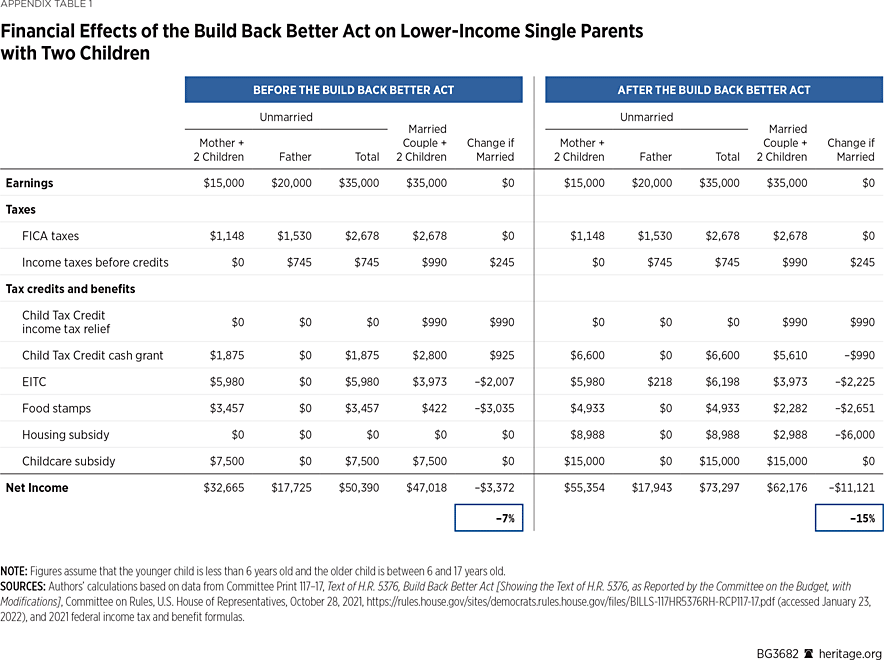
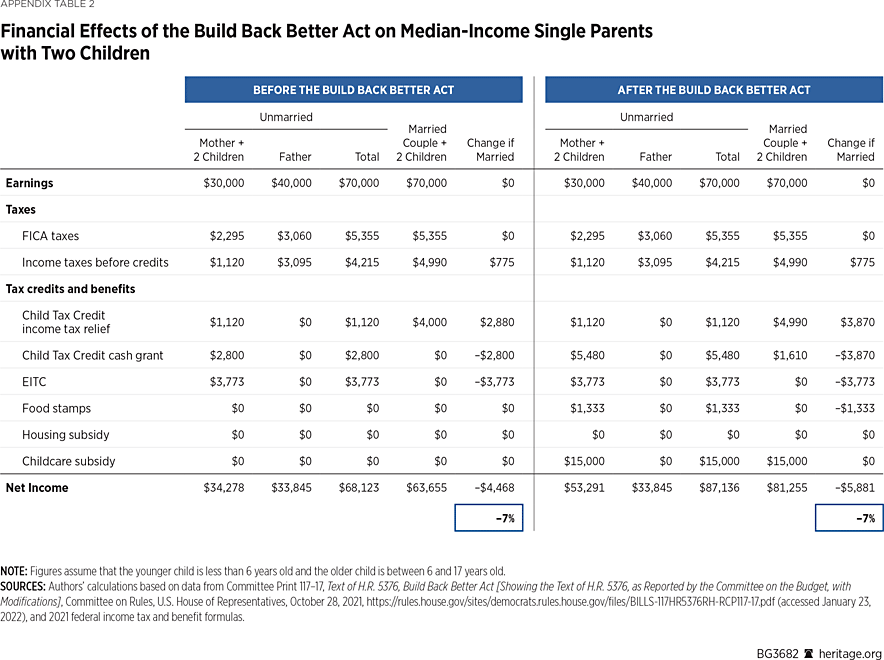

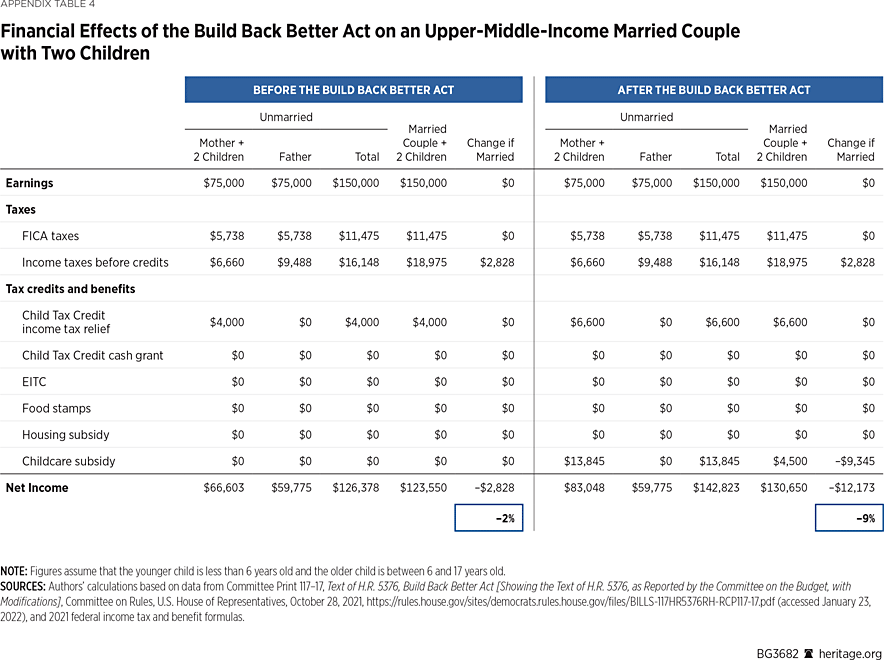

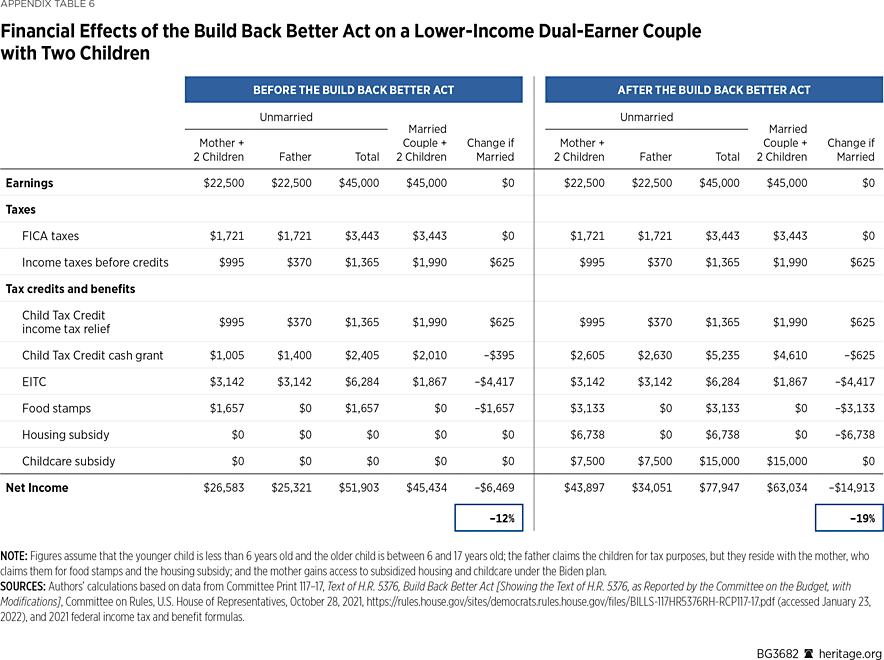
Appendix 2
List of Papers Showing the Impact of Higher Welfare Supports on Family Formation, Marriage, and the Non-Marital Birth Ratio
Bernstam, Mikhail S., “Malthus and Evolution of the Welfare State: An Essay on the Second Invisible Hand, Parts I and II,” Hoover Institution Working Papers E-88-41, E-88-42, 1988.
Fitzgerald, John M., and David C. Ribar, “Transitions in Welfare Participation and Female Headship,” Population Research and Policy Review, Vol. 23, Nos. 5–6 (October 2004), pp. 641–670.
Fossett, Mark A., and K. Jill Kiecolt, “Mate Availability and Family Structure Among African Americans in U.S. Metropolitan Areas,” Journal of Marriage and Family, Vol. 55, No. 2 (May 1993), pp. 288–302.
Hill, M. Anne, and June O’Neill, “Underclass Behaviors in the United States: Measurement and Analysis of Determinants,” City University of New York, Baruch College, Center for the Study of Business and Government, February 1992.
Hoffman, Saul D., and E. Michael Foster, “AFDC Benefits and Nonmarital Births to Young Women,” The Journal of Human Resources, Vol. 35, No. 2 (Spring 2000), pp. 376–391.
Horvath-Rose, Ann E., H. Elizabeth Peters, and Joseph J. Sabia, “Capping Kids: The Family Cap and Nonmarital Childbearing,” Population Research and Policy Review, Vol. 27, No. 2 (April 2008), pp. 119–138.
Jackson, Catherine A., and Jacob Alex Klerman, “Welfare, Abortion and Teenage Fertility,” RAND Research Paper, August 1994.
Jagannathan, Radha, “A Latent Growth Curve Model of Nonmarital Births, Abortions, and Pregnancies: Did Welfare Reform Play a Role in Changing the Trajectories?” Marriage and Family Review, Vol. 48, No. 4 (2012), pp. 363–385.
Jagannathan, Radha, Michael J. Camasso, and Carol Harvey, “The Price Effects of Family Caps on Fertility Decisions of Poor Women,” Journal of Social Service Research, Vol. 36, No. 4 (2010), pp. 346–361.
Lundberg, Shelley, and Robert D. Plotnick, “Adolescent Premarital Childbearing: Do Opportunity Costs Matter?” University of Washington, Department of Economics, Working Paper No. 90-23, 1990.
Murray, Charles, “Welfare and the Family: The U.S. Experience,” Journal of Labor Economics, Vol. 11, No. 1, Pt. 2 (1993), pp. 224–262.
Nechyba, Thomas J., “Social Approval, Values, and AFDC: A Reexamination of the Illegitimacy Debate,” Journal of Political Economy, Vol. 109, No. 3 (June 2001), pp. 637–672.
Ozawa, Martha N., “Welfare Policies and Illegitimate Birth Rates Among Adolescents: Analysis of State-by-State Data,” Social Work Research & Abstracts, Vol. 25, No. 1 (March 1989), pp. 5–11.
Plotnick, Robert D., “Welfare and Out-of-Wedlock Childbearing: Evidence from the 1980s,” Journal of Marriage and Family, Vol. 52, No. 3 (August 1990), pp. 735–746.
Robins, Phillip K., and Paul Fronstin, “Welfare Benefits and Family Size Decisions of Never-Married Women,” University of Wisconsin, Institute for Research on Poverty, Discussion Paper No. 1022-93, September 1993.
Rosenzweig, Mark R., “Welfare, Marital Prospects, and Nonmarital Childbearing,” Journal of Political Economy, Vol. 107, No. 6, Pt. 2 (December 1999), pp. S3–S-32.
Sabia, Joseph J., “Blacks and the Family Cap: Pregnancy, Abortion, and Spillovers,” Journal of Population Economics, Vol. 21, No. 1 (January 2008), pp. 111–134.
Schultz, T. Paul, “Marital Status and Fertility in the United States,” The Journal of Human Resources, Vol. 29, No. 2 (Spring 1994), pp. 637–669.
South, Scott J., and Kim M. Lloyd, “Marriage Markets and Nonmarital Fertility in the United States,” Demography, Vol. 29, No. 2 (May 1992), pp. 247–264.
Willis, Robert J., “A Theory of Out-of-Wedlock Childbearing,” Journal of Political Economy, Vol. 107, No. 6, Pt. 2 (December 1999), pp. S33–S64.
Winegarden, C. R., “AFDC and Illegitimacy Ratios: A Vector-Autoregressive Model,” Applied Economics, Vol. 20, No. 12 (1988), pp. 1589–1601.



